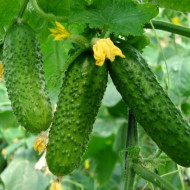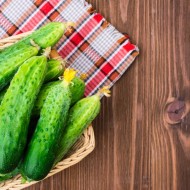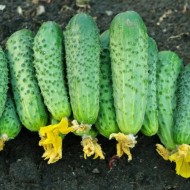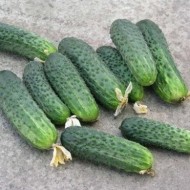What is a parthenocarpic variety of cucumbers - 15 varieties with descriptions and photos
Content
- 1 The history of the emergence of parthenocarpic cucumber
- 2 Properties of parthenocarpic varieties
- 3 Video "What are parthenocarpic cucumbers"
- 4 Advantages and disadvantages of the view
- 5 The best varieties of parthenocarpic cucumbers for greenhouses
- 6 The best varieties of parthenocarpic cucumbers for outdoor use
- 7 Features of agricultural technology
The history of the emergence of parthenocarpic cucumber
Parthenocarp is the fertilization of plants without pollination, which leads to the formation of seedless fruits. In the wild, such cucumbers grew many centuries ago in the territory of modern Asian countries.
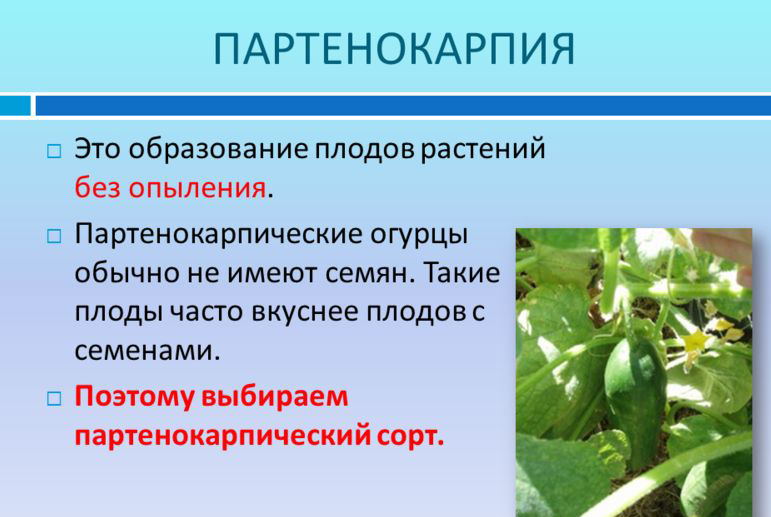
Breeders began to work on the first parthenocarpic hybrids starting in the 1950s. Then vegetables were long (up to 40 cm) fruits of emerald color, which were not suitable for conservation. A little later, science brought out new varieties, not much different from the usual ones in taste, shape, color and size.
Properties of parthenocarpic varieties
Self-pollinated culture very quickly spread among gardeners around the globe. The first was the significant decline in the population of pollen-carrying insects. However, parthenocarpic cucumbers have become popular for other reasons as well:
- high productivity;
- lack of bitterness;
- rapid growth and vigor of the bushes;
- duration of continuous fruiting;
- frost resistance;
- increased immunity to cucumber diseases.
Video "What are parthenocarpic cucumbers"
In this video, he talks about the benefits and features of growing parthenocarpic hybrids.
Advantages and disadvantages of the view
Compared to conventional pollinated varieties, hybrids have several advantages:
- a large number of ovaries on one shoot;
- fast ripening of the crop;
- the possibility of growing cucumbers in greenhouse conditions or in an apartment;
- fruits are even, uniform in shape and color, without internal voids;
- with a long stay on the bush, vegetables do not turn yellow;
- good keeping quality;
- long-term storage.
However, parthenocarpic varieties have one insignificant drawback: planted in open ground and pollinated by bees, they can produce fruits of irregular shape or color.
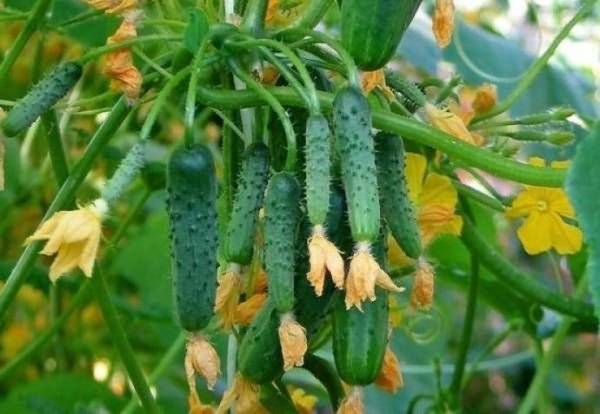
The best varieties of parthenocarpic cucumbers for greenhouses
Parthenocarpic hybrids were bred specifically for greenhouse cultivation. That is why there are so many greenhouse varieties. Below we will look at the most popular ones.
F1 advance
Early maturing determinant variety. The fruits are lumpy, emerald in color with whitish "thorns". Their average weight is 110–130 g with a standard length of 12 cm. Cucumbers are sweetish in taste, have a crunchy texture, are suitable for preservation and long-term storage. The first crop is ready for harvest 40–44 days after the first shoots appear. From 1 sq. m you can remove up to 13 kg of vegetables.
April F1
Early ripening variety.The fruits are large, lumpy, with whitish "thorns". Weighing 150-300 g, they have an average size of 15-23 cm. Cucumbers have a distinct taste and are good for fresh consumption. The hybrid is characterized by increased productivity, which is 12-13 kg per 1 sq. m. Collection time begins 40-50 days after germination.
F1 White Angel
The most controversial parthenocarpic hybrid with a white skin. An early ripening hybrid can be harvested within 40-50 days after the first shoots appear. The fruits are not very thick, even, with a maximum length of 11 cm, with a sweetish taste. Suitable for preservation, but it is better to use fresh. From 1 sq. m White Angel F1 gives 12-15 kg of fruit.
Herman F1
A very early ripening variety (36–42 days). Differs in the duration of fruiting - from the beginning of summer to the second decade of September. Fruits of a dark green hue have almost the same size, reaching 8-10 cm, and weighing from 70 to 100 g. They have a pronounced taste and are often used for pickling. Average yield from 1 sq. m is 20-25 kg.
Emelya F1
Early maturing indeterminate variety. Ripening occurs 39–42 days after germination. Fruits are lumpy, bright green, with whitish "thorns", elongated. Their size is 13-15 cm and weighs 120-150 g. Cucumbers are covered with thin skin and have a sweetish taste. Suitable for salads, preservation, pickling. From 1 sq. m you can harvest 12-16 kg.
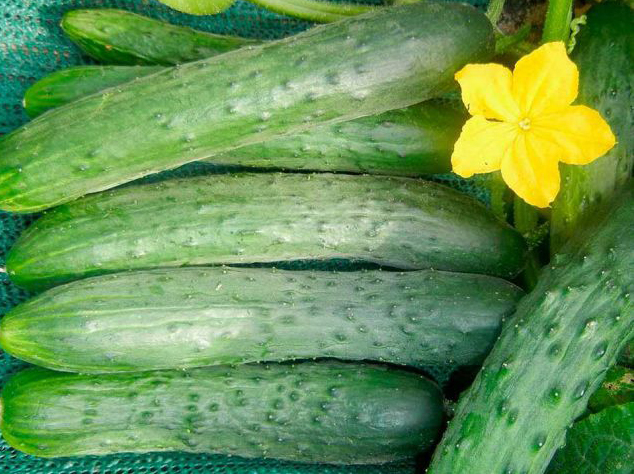
Emerald Stream F1
Early ripening variety - the first crop is ready for harvest 40–44 days after the first shoots appear. The fruits are long, slightly curved, 30-50 cm in size and weighing 200-300 g. The peel of an emerald hue is covered with small whitish "thorns". Crispy cucumbers with sweetish pulp and small seeds. Productivity from 1 sq. m is 5-7 kg.
Variety Emerald Stream F1 is not intended for conservation or pickling.
Miranda F1
An early maturing indeterminate hybrid that gives the first harvest already 40–45 days from germination. Fruits are small (10–12 cm), weighing 110 g, covered with thick green skin and whitish stripes. "Spines" are white, medium hard. Cucumbers have a crispy pulp with a rich taste, suitable for salads, pickling, preservation. From 1 sq. m it is possible to collect up to 7 kg of vegetables.
Orlik F1
A variety of universal purpose, early ripening. Cucumbers can be harvested 47-50 days after the first shoots appear. Fruits are lumpy, with whitish "thorns", measuring from 14 to 16 cm and weighing 120–150 g. The flesh is crispy, rich in taste, without bitterness. Productivity from 1 sq. m is 6-8 kg.
F1 picnic
An early ripe hybrid that can be harvested all summer, starting from 42–48 days from germination. Fruits are even, elongated, lumpy, covered with a thin emerald skin and small “thorns”. The size of cucumbers is 11 cm with an average weight of 95–100 g. The variety is distinguished by high fruiting (11–12 kg / sq. M) and universal purpose.
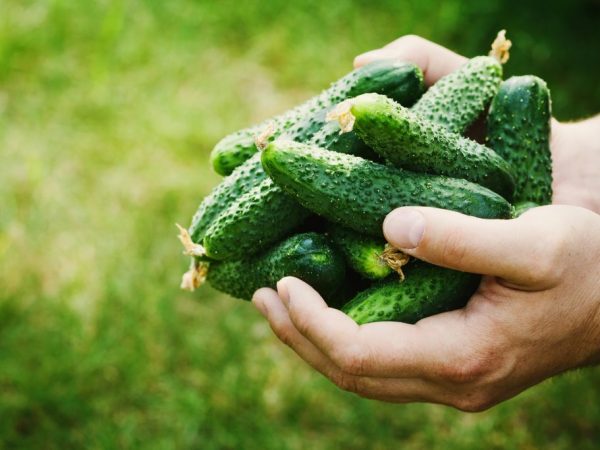
The best varieties of parthenocarpic cucumbers for outdoor use
Despite the fact that self-pollinated hybrids were bred for greenhouses, there are many varieties that are successfully grown in garden beds. Below we will look at some of them.
Athena F1
Early maturing indeterminate variety of generative type. The fruits are lumpy, even, 10–12 cm long, weighing 70–90 g. They are covered with a dark emerald skin with whitish stripes and “thorns”. The cucumbers are crispy, sweet, and have a rich taste. Suitable for making salads. Productivity from 1 sq. m is only 3 kg.
Friendly family F1
An indeterminate variety with a medium early ripening period, which begins to bear fruit 45–50 days after germination and continues until the first frost. Fruits of universal purpose are 10–12 cm in size with an average weight of 80–100 g.Cucumbers are very lumpy, covered with whitish "thorns". From 1 sq. m can be harvested up to 10 kg of crop.
Irina F1
An early ripe hybrid that ripens 42–45 days after the first shoots appear. Differs in increased fruiting (up to 12.5 kg / sq. M). Fruits are emerald in color, with large tubercles, light stripes and whitish "thorns". The size of vegetables is 8–12 cm with a mass of 60–80 g. The cucumbers are crispy, sweetish, suitable for universal use.
Christina F1
An early ripening variety with fruit ripening at 40–42 days from the first shoots. Cucumbers 8–10 cm in size and weighing 50–90 g are covered with a thin, hilly peel and whitish "thorns". Vegetables have a crispy flesh and are well suited for preservation or salting. Productivity from 1 sq. m is 10 kg.
Masha F1
Determinant variety of early ripening. The first crop is ready for harvest 36–40 days after the first shoots appear. The average yield is 10-11 kg / sq. m. Fruits are small (up to 10 cm), weighing 90-100 g, covered with a thick green skin with light stripes. Cucumbers are suitable for salads, canning, pickling.
Pasamonte F1
A hybrid of universal purpose, it belongs to early ripening varieties. Full ripening occurs on the 42nd day from the first shoots. Fruits are small (8-9 cm), weighing from 70 to 120 g, covered with an emerald peel with small whitish "thorns". The pulp is crispy, sweetish, aromatic. Productivity per 1 sq. m is 10-15 kg.
- Pasamonte F1
- Masha F1
- Christina F1
- Irina F1
- Friendly family F1
- Athena F1
Features of agricultural technology
Growing self-pollinated cucumbers is not particularly difficult. This can be done in greenhouse conditions or in open beds. Each method has its own secrets, which we will discuss below.
Common ways of planting seeds
Since the purchased material has a low degree of germination, it is recommended to sow several seeds at once or plant one, but already hatched. Planting can be done directly into the soil or using special cups made of pressed peat.
Before starting sowing, the planting material must be soaked. Dry seeds are dipped for half an hour in a weak solution of manganese, and then thoroughly washed under running water. The disinfected seeds are wrapped in wet gauze, sealed with polyethylene and left for 24 hours. A day later, the "envelopes" begin to harden. To do this, use a refrigerator, where future seedlings are kept for 2 days.
Indoor cultivation
For normal germination, the seeds are kept in peat tablets at a humidity of 75% and a temperature of +27 ° C. When the first shoots appear, the indicator is reduced to +21 ° C. The transplant is carried out in the presence of 3-4 full-fledged leaves, not earlier than on the 25th day after disembarkation. The holes are made with an interval of 50–150 cm and a size of 30x30 cm. The soil mixture should be neutral and well fed.
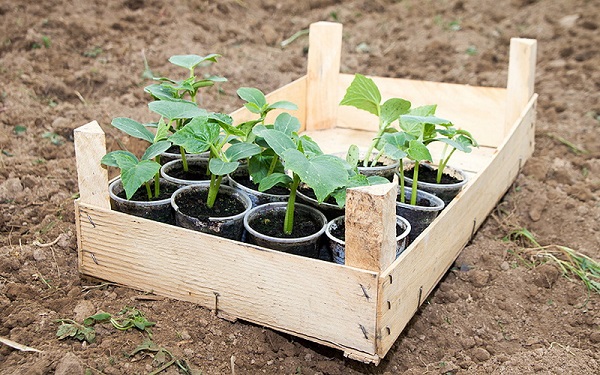
The planted seedlings are mulched and watered regularly. Before flowering, the dose is 4 l / bush. After the formation of ovaries, the frequency of watering is increased.
The first feeding is done in the fourth week after transplantation. For this, potassium-phosphorus compositions are used. Organic fertilizers (manure or bird droppings) are applied after 1.5–2 weeks. The procedures are alternated throughout the growing season.
So that the shoots do not break off, grow evenly and withstand the weight of the fruits, they are tied to vertical trellises, fastening the top to a horizontal wire.
When planting seeds directly into open ground, the agrotechnical algorithm does not differ from growing seedlings. It is necessary to sow the planting material at a temperature not lower than +15 ° С.
Outdoor cultivation
The place for the beds should be well lit and protected from drafts. They begin to prepare the soil even before winter. It is weeded out, removing weeds, and then manure mixed with wood ash is introduced.
In the spring, when warm, sunny weather sets in, they start sowing seeds. The planting material is placed in shallow moistened grooves at a distance of 4 cm from each other, and then covered with earth from above. When the first shoots hatch, the seedlings dive, leaving an interval of 5-15 cm between the bushes.
Young cucumbers are poured with warm water. One plant takes about 1.5 liters. After the formation of the ovaries, the volume and frequency are doubled, and in dry weather, the procedure is carried out daily.
Plants are fertilized every 1.5–2 weeks, alternating organic and mineral fertilizing. When the seedlings get stronger, care for them becomes the same as when growing in greenhouses.

Harvesting and storage
Harvesting must be done every two days. Thus, the cucumbers will not overripe, and new ovaries will form faster. That is, the timely removal of fruits provides increased fruiting.
Despite the fact that hybrid varieties have good keeping quality, they need to be kept in a refrigerator or a cool place without access to sunlight.
Parthenocarpic hybrids are increasingly gaining popularity among gardeners. But does this mean that you need to give up regular cucumbers? Our answer: it is better to combine traditional varieties with self-pollinated ones.

